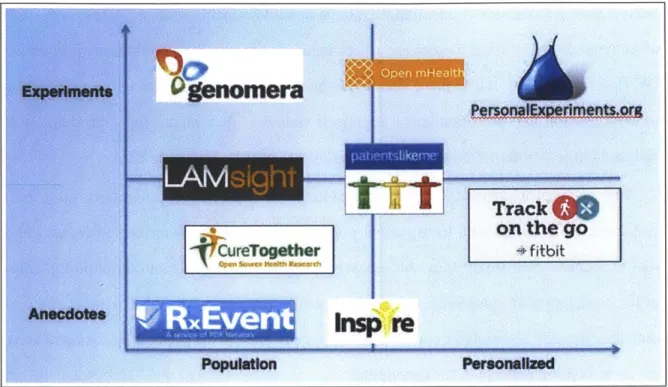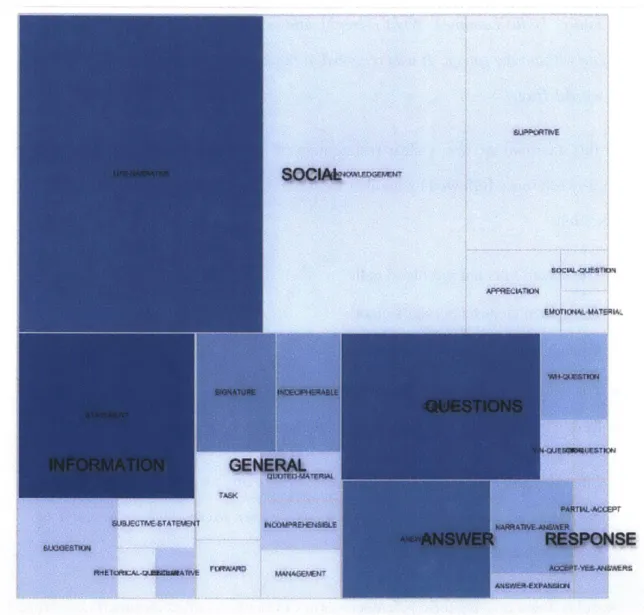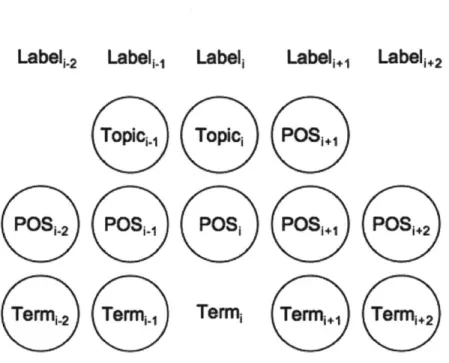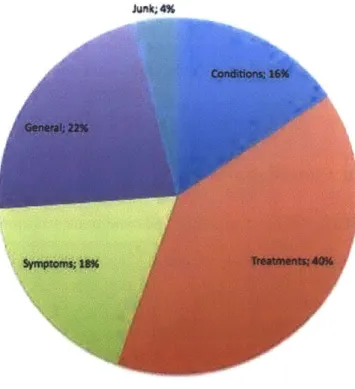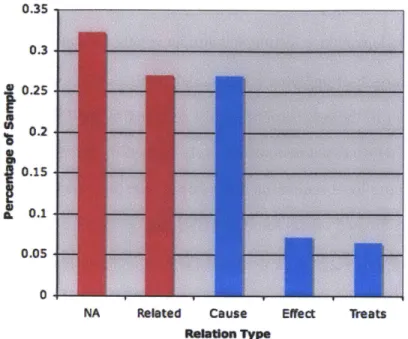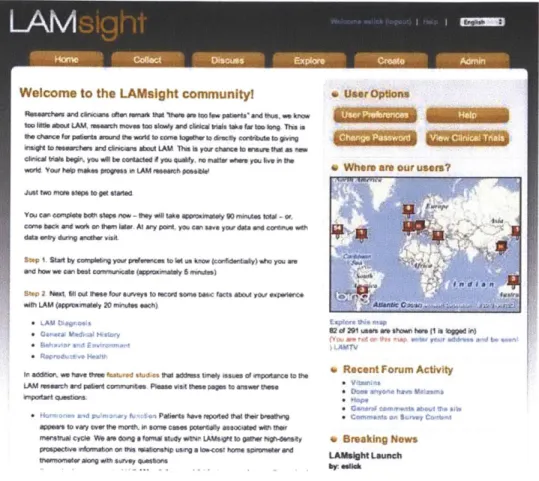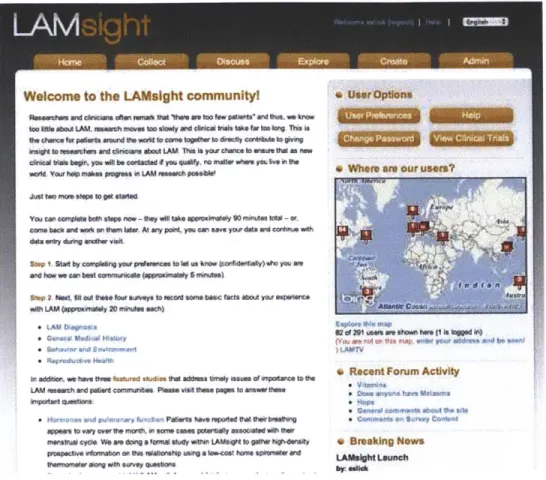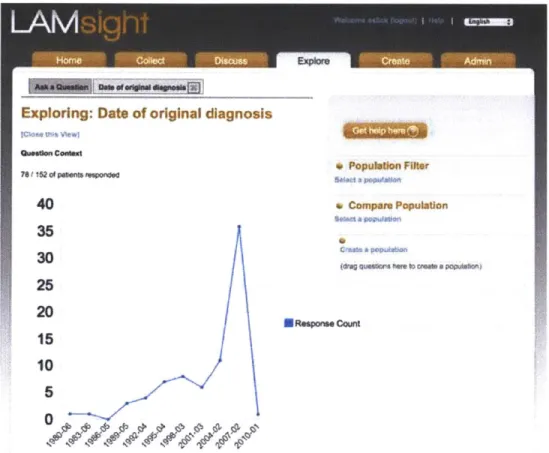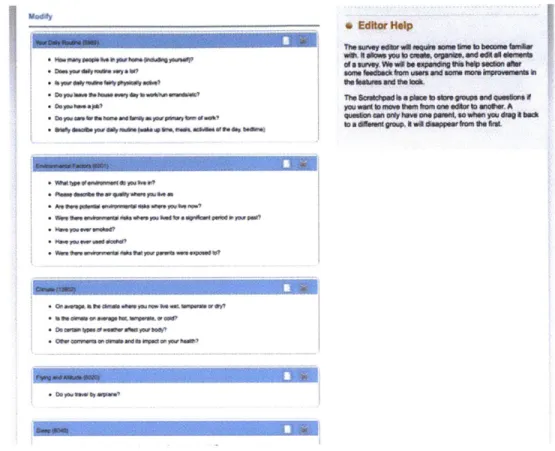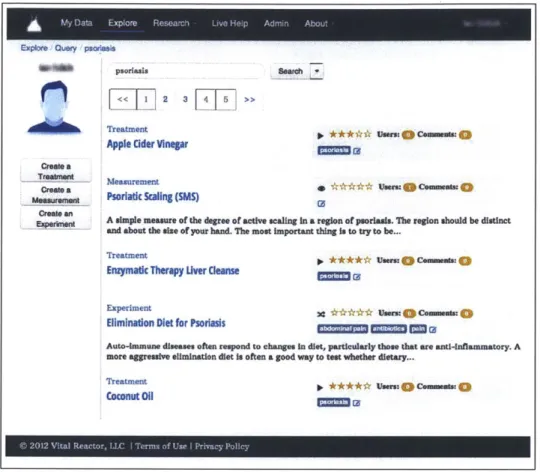Crowdsourcing Health Discoveries:
from Anecdotes to Aggregated Self-Experiments
by
Ian Scott Eslick
Submitted to the Program in Media Arts and Sciences
School of Architecture and Planning
in partial fulfillment of the requirements for the degree of
Doctor of Philosophy
at the
MASSACHUSETTS INSTITUTE OF TECHNOLOGY
MASSACHUSETTS 1WTrftftE
OF TECHNOLOGY
JUL 14 2014
LIBRARIES
September 2013
@
Massachusetts Institute of Technology 2013. All rights reserved.
Author ....
Signature redacted
Certified by ...
S
Program in Media-'
s and Sciences
School of Architecture and Planning
August 9th, 2013
ignature redacted
FrankMoss
K
Professor of the Practice of Media Arts and Sciences
Thesis Supervisor
Signature
Accepted by ...
redacted
Pattie Maes
Associate Academic Head
Program in Media Arts and Sciences
Crowdsourcing Health Discoveries:
from Anecdotes to Aggregated Self-Experiments
by
Ian Scott Eslick
Submitted to the Program in Media Arts and Sciences School of Architecture and Planning
on August 9th, 2013, in partial fulfillment of the requirements for the degree of
Doctor of Philosophy
Abstract
Nearly one quarter of US adults read patient-generated health information found on blogs, forums and social media; many say they use this information to influence everyday health decisions. Topics of discussion in online forums are often poorly-addressed by existing, clinical research, so a patient's reported experiences are the only evidence. No rigorous methods exist to help patients leverage anecdotal evidence to make better decisions.
This dissertation reports on multiple prototype systems that help patients augment anec-dote with data to improve individual decision making, optimize healthcare delivery, and accelerate research. The web-based systems were developed through a multi-year col-laboration with individuals, advocacy organizations, healthcare providers, and biomedical researchers. The result of this work is a new scientific model for crowdsourcing health insights: Aggregated Self-Experiments.
The self-experiment, a type of single-subject (n-of-1) trial, formally validates the effec-tiveness of an intervention on a single person. Aggregated Personal Experiments enables user communities to translate anecdotal correlations into repeatable trials that can validate efficacy in the context of their daily lives. Aggregating the outcomes of multiple trials im-proves the efficiency of future trials and enables users to prioritize trials for a given condi-tion. Successful outcomes from many patients provide evidence to motivate future clinical research. The model, and the design principles that support it were evaluated through a set of focused user studies, secondary data analyses, and experience with real-world deploy-ments.
Thesis Supervisor: Frank Moss
Crowdsourcing Health Discoveries:
from Anecdotes to Aggregated Self-Experiments
by
Ian Scott Eslick
The following people have served on the committee for this thesis:
Signature redacted
... t...
Frank Moss Professor of the Practice of Media Arts and Sciences MIT Media Laboratory
Si gnature redacted
...
Henry LiebermanPrincipal Research Scientist MIT Media Laboratory
Signature redacted
Peter Szolovits Professor of Computer Science and Engineering MIT Department of EECS
Acknowledgments
I would like to thank the members of my committee who have encouraged me in the
pur-suit of this dissertation. Without the extraordinary support of my advisor, Professor Frank Moss, this work would never have been completed. Professor Peter Szolovits brought a wealth of experience from Al and medicine and has been an invaluable source of encour-agement and grounding, particularly for some of the more esoteric ideas I've generated over the years. Dr. Henry Lieberman's creativity, especially in user interfaces and user engagement, has been both genuinely delightful and instructive.
I would also like to thank Linda Peterson and the rest of the MAS administration for
their support of my unconventional path to this dissertation.
No large body of work is completed without significant emotional and logistical sup-port. My wife Mary Kelly has been my champion from the day I decided to return to academia. I appreciate all the wisdom she's shared from her own PhD experience. My par-ents' support of our family during several critical years made sustaining this effort possible through some trying circumstances. My children have been endlessly patient with long nights, weekends at the office, and travel. I look forward to making that up to them.
My mother-in-law Judy Hallagan, herself a nurse and former clinical researcher, has
shared with me a unique window into the dysfunction and inhumanity of modern health-care. It is a window none of us wanted to have to look through, but walking the path with her has taught me a great deal while simultaneously fueling my sense of outrage.
Finally, several organizations have been key collaborators and supporters of this work. To Compass Labs, Lybba, NEA, the C3N Project of the Cincinnati Children's Hospital, ImproveCareNow, and the LAM Treatment Alliance: I will be forever grateful for your
Contents
1 Introduction 23
1.1 Crowdsourcing Health Insights . . . . 25
1.2 Personalized and Evidence-Based Medicine . . . . 28
1.3 Research Context . . . . 29 1.4 Experiments in Practice . . . . 31 1.5 Aggregated Self-Experiments . . . . 33 1.6 R esults . . . . 35
I Research Context
37
2 Related Work 39 2.1 Emerging Disciplines . . . . 39 2.1.1 Peer-to-Peer Healthcare . . . . 40 2.2 Related Platforms . . . . 412.2.1 Tracking and Aggregation . . . . 42
2.2.2 Experimentation . . . . 43
2.2.3 Collective Intelligence . . . . 44
2.2.4 Quantified Self . . . . 45
2.2.5 The Learning Healthcare System . . . . 45
2.4 Design and Analysis of Clinical Trials . .
2.5 Single Patient Trials . . . .
2.5.1 Aggregated N-of-I Trials . . . . .
2.5.2 Self-experimentation . . . .
2.5.3 Measurement . . . .
2.6 Bayesian Modeling and Belief Updating .
2.6.1 Belief Update . . . .
3 Health Social Media Forums
3.1 Online Health Forums . . . .
3.2 Corpus and Patient Language . . . . 3.2.1 Semantic Knowledge . . . .
3.2.2 Speech Acts . . . .
3.2.3 Anaphoric References and Implicit 3.2.4 Identifying Clinical Terminology
Context 3.2.5 Topic Models 3.2.6 Corpus Summary . . . . . 3.3 Representation . . . . 3.3.1 Semantic Relations . . . . 3.3.2 Networks of Relations 3.3.3 Target Representation 3.4 Information Extraction . . . . 3.4.1 Extraction Example . . . 3.4.2 Constituent Extraction . 3.4.3 Relation Identification . 3.4.4 Bootstrapping . . . .
3.5 Preliminary Extraction Results . .
3.5.1 Constituent Identification . 48 50 53 53 54 55 57 59 60 61 62 64 67 68 69 71 72 74 74 76 77 79 81 82 84 85 85 . . . .
3.5.2 Relation Extraction . . . 87
3.5.3 Discussion . . . 87
3.6 Implications . . . 90
4 Aggregating Patient Reported Outcomes 91 4.1 Origin of LAMsight . . . 92
4.2 Design and Features . . . 93
4.3 Community Reception . . . 95
4.4 Results. . . . .. .. . . . .. . . . 97
4.4.1 Patient Questionnaires . . . 97
4.4.2 Researcher Questions . . . 98
4.4.3 A Study of Pulmonary Function . . . 98
4.5 Lessons Learned . . . 101
II Aggregated Self-Experiments
105
5 Extended Example 107 5.1 Case Review . . . 1075.2 Seeking Help Online . . . 109
5.3 Personal Experiments . . . 110
5.4 Alice's Trials . . . 117
5.4.1 Glycerin and Witch Hazel for Psoriasis . . . 117
5.4.2 Turmeric for Psoriasis . . . 120
5.4.3 Restriction Diet for Fatigue . . . 122
5.4.4 Pagano Diet for Psoriasis . . . 123
5.5 Six Months Later . . . 126
6.1 Hypothesis Space . . . 127
6.2 Individual Process Model . . . 129
6.2.1 Minimizing Decisions . . . 131
6.3 Designing Experiments . . . 133
6.3.1 Sharing and Peer Review . . . 134
6.3.2 Replication . . . 135
6.3.3 Improving Designs . . . 136
6.4 Reducing Trial Burden . . . 136
6.4.1 Optimizing Sample Size . . . 137
6.4.2 Accommodating Confounding Factors . . . 138
6.5 Computing the Probability of Success . . . 139
6.5.1 Recommending Experiments . . . 140
6.6 Deciding to Continue . . . 141
6.7 The Population Hypothesis Space . . . 141
6.7.1 Predictor Discovery. . . . 142
6.7.2 Causal Analysis. . . . 142
6.7.3 Ethical Considerations . . . 143
7 Algorithms 145 7.1 The Single-Subject Trial as Decision Aid . . . 145
7.2 The Ideal Trial . . . 148
7.2.1 Measurement and Variability . . . 148
7.2.2 Normalized Treatment Effects . . . 150
7.2.3 Planning a Trial . . . 151
7.2.4 Updating Beliefs . . . 153
7.2.5 Interpreting the Trial Outcome . . . 154
7.2.6 Visual Outcomes . . . 154
7.3.1 Time series effects . . . . 7.4 Confounding . . . . 7.4.1 Learning from Special Causes
7.5 Recommending Experiments . . . . .
8 Prototype Design
8.1 Site Navigation . . . .
8.2 Data Model . . . . 8.2.1 Support for Data Acquisition . . . . .
8.2.2 Treatments . . . .
8.2.3 Experiments and Trials . . . . 8.2.4 Miscellaneous . . . . 8.3 Consumer Tracking Workflow . . . .
8.3.1 Tracking . . . .
8.3.2 Interpreting Evidence . . . . 8.4 Consumer Experimentation Workflow . . . .
8.4.1 Trial Actions . . . . 8.4.2 Visualizing Trial Data . . . . 8.4.3 Trial Outcome Reporting . . . . 8.4.4 Successful Treatments and Abandoned
8.5 Collaboration Features . . . .
8.5.1 Discussion . . . .
8.5.2 Ratings . . . .
8.5.3 Trial Peer Review . . . . 8.5.4 Experiment Peer Review . . . .
8.6 Aggregation Support . . . . 8.7 MyIBD Deployment . . . . 8.8 Technology Architecture . . . . 161 . . . 162 . . . 1 6 4 . . . 1 6 5 . . . 17 5 . . . 176 . . . 1 8 0 . . . 1 8 0 . . . 1 8 1 . . . 1 8 3 . . . 18 4 . . . 1 8 5 . . . 1 8 7 . . . 1 8 8 Trials . . . 188 . . . 1 8 9 . . . 1 8 9 . . . 1 8 9 . . . 1 9 0 . . . 1 9 0 . . . 19 0 . . . 19 1 . . . 19 5 156 158 159 159
Server Architecture . . . .
Client Architecture . . . . Deployment . . . .
Performance . . . .
Lessons Learned . . . .
III Evaluation and Discussion
9 Evaluation
9.1 Users Can Design Self-Experiments
205
207
. . . 207
9.1.1 Spontaneous experimentation on social media forums . . . 208
9.1.2 Edison: The Experimenter's Journal . . . 210
9.1.3 Experiment Design Survey . . . 213
9.1.4 Designs from Personal Experiments . . . 215
9.1.5 Discussion . . . 216
9.2 Users can Execute and Learn from Self-Experiments . . . 216
9.2.1 C3N/ImproveCareNow N-of-I Experience . . . 217
9.2.2 Personal Experiments for Self-Tracking . . . 218
9.2.3 Personal Experiments User Study . . . 219
9.2.4 Uses of Personal Experiments in the wild . . . 227
9.2.5 Discussion . . . 228
9.3 Learning from the outcomes of multiple trials . . . 229
9.3.1 Analysis of Variance . . . 230
9.3.2 Optimizing Sample Size . . . 231
9.3.3 Improving Designs . . . 233 9.4 Aggregated Self-Experiments will have a Dramatic Impact on Healthcare
9.4.1 Doctor-patient Relationships . . . . 235 235 8.8.1 8.8.2 8.8.3 8.8.4 8.8.5 196 197 198 201 201
9.4.2 Supporting Hypotheses for Research . . . . 9.4.3 The Learning Health System . . . .
9.5 Observations from Early Prototypes . . . .
10 Future Work
10.1 Improving Trial Design
10.1.1 Exploiting Covariat
10.1.2 Discovering Carryov
10.1.3 Modeling Transition
10.1.4 Improved Modeling
10.1.5 Retesting the Baseli
10.1.6 Empirically Chosen
10.2 Alternative Trial Designs 10.2.1 Short Onset/Offset 10.2.2 The "Two Armed" E
10.2.3 Factorial Design . 10.2.4 Dose-Response Tria 10.2.5 Dynamic Trials . . 10.3 Surrogate Measures . . . . 10.3.1 Surrogate Measures 10.3.2 Passive Measures 10.4 Combination Treatments
10.5 Accommodating Global Cot
10.6 User Interface Elements . .
10.6.1 Tagging Taxonomy 10.6.2 Medical Taxonomy 10.6.3 Variable Control Li 245 . . . 245 s . . . 246 er Effects . . . 246 s . . . 247 Fidelity . . . 247 ne . . . 248
Effect Size Categories . . . 248
. . . 248 . . . 249 ody . . . 249 . . . 249 Is . . . 250 . . . 250 . . . 251
for Clinical Outcom es . . . 251
. . . 252 . . . 252 straints . . . 253 . . . 253 . . . 253 . . . 254
nits for Run Charts . . . 254
10.7 Integration with Health Social Media Forums
. 238 . 238 . 243
11 Conclusion
A Social Media Content
A. 1 Edison Experiments ...
A.2 Patient Experiments: TalkPsoriasis . . . . A.2.1 Slippery Elm Treatment...
A.3 Patient Treatment Advice: TalkPsoriasis
A.4 Blog post by a Personal Experiments User
B Personal Experiments and MyIBD Catalogs B.1 User Study Experiments . . . . B.2 Personal Experiments Catalog . . . . B.2.1 Experiments . . . . B.2.2 Instruments . . . . 261 . . . 26 1 . . . 264 . . . 264 . . . 265 . . . 268 271 . . . 2 7 1 . . . 278 . . . 278 . . . 290 257
List of Figures
2-1 Platform Comparison . . . .
Density of medical content by speech act . Manual Spleen Causal Model . . . . Conditional Random Field Features . . .
A Relation Context Window . . . .
Precision of Constituent Terms . . . . Relation Labels . . . .
The LAMsight Home Page LAMsight Data Collection LAMsight Data Explorer .
I A Mci;ht 4Zurvex Pditor
g y . . . .
4-5 Hormone levels during the female menstrual cycle [IsoO9] . .
4-6 FEV1/FEV6 with menstrual onset (red) and LH surge (green) .
Searching for Psoriasis-related Information . . . . . Measurement, Treatment, and Experiment Views . . Configuring a Trial . . . . User Dashboard . . . .
Trackers, Trial Control Charts, and Journaling . . . .
Glycerin and Witch Hazel, Intermediate Trial Results
. . . . 67 . . . . 80 . . . 82 . . . 83 . . . 86 . . . . 87 . . . 93 . . . 94 . . . 95 . . . . 96 . . . 100 . . . 102 111 112 114 115 116 119 . . . 42 3-1 3-2 3-3 3-4 3-5 3-6 4-1 4-2 4-3 4-4 5-1 5-2 5-3 5-4 5-5 5-6 . . .
Hypothesis space for a single user . . . . Alice's Scientific Method . . . . Mechanisms to Support Individual Decision Making 6-4 Process Model . . . .
6-5 Community Science . . . .
6-6 Producers and Consumers . . . .
6-7 Common Single-Subject Designs . . . .
6-1 6-2 6-3
7-1 AB Trial with Treatment Effect .
7-2 Cohen's d Effect Sizes . . . . . 7-3 Statistical Model . . . .
8-1 Top Navigation Header . . . . .
8-2 Personal Experiments Site Map . 8-3 Search Interface 8-4 8-5 8-6 8-7 8-8 8-9 8-10 8-11 8-12 8-13 8-14 8-15 Dashboard Page . . . .
Chart Review Page . . . .
High Level Data Schema . Measure View . . . . Measure Fields . . . . Tracker Management . . . Tracker Fields . . . . Configuring a Tracker . . . Service Configuration . . . Photo of an SMS "Thread" Treatment View . . . . Treatment Fields . . . . . on an 149 151 152 162 162 163 164 165 166 167 167 169 169 170 170 172 175 175 176 iPhone 8-16 Experiment View . . . 128 . . . 130 . . . 131 . . . 132 . . . 133 . . . 134 . . . 139 . . . . . . .
8-17 Experiment Fields . . . 176
8-18 Advanced Experiment Fields . . . 177
8-19 Create a Trial . . . 178
8-20 Trial Fields . . . 179
8-21 Advanced Trial Fields . . . 179
8-22 Search Result Detail . . . 181
8-23 My Charts Page . . . 182
8-24 Dashboard Trial Widget: Active Trial . . . 184
8-25 Timeline Control Chart . . . 187
8-26 MyIBD Login Page . . . 191
8-27 MyIBD Learning Plan Page . . . 192
8-28 MyIBD De-identified Population Browser . . . 193
8-29 MyIBD Clinician Chart Review . . . 194
8-30 Platform Architecture . . . 196
8-31 Deployment Architecture . . . 199
9-1 Slippery Elm Trial . . . 209
9-2 Edison Experiment Categories . . . 212
9-3 Coded Edison Experiments . . . 213
9-4 Experiment Design Survey compared to Edison . . . 214
9-5 Population Ages . . . 220
9-6 Prior Self-Trackers9 . . . 221
9-7 Population Occupations . . . 222
9-8 Selected Interventions . . . 222
9-9 Trial of Increase Exercise to Increased Total Sleep . . . 224
9-10 Trial of Melatonin Dose impact on Deep Sleep . . . 225
9-11 Use of Tea Tree Oil to Reduce Itching from Tinea Versicolor . . . 226
9-13 Herbal Liver Treatment for Fatigue in a Psoriasis Patient
9-14 Deep sleep has a typical Cohen's d = 0.5 . . . . 9-15 Deep sleep ratio has a typical Cohen's d = 1.0 . . . . 9-16 Study Population Total Sleep . . . . 9-17 Sample size for a two-tailed t-test . . . . 9-18 Simulated Sample Sizes . . . . 9-19 Cystic Fibrosis Symptom Chart . . . . 9-20 MyIBD Ad-Hoc Interventions . . . . 9-21 MyIBD Transplant Recovery Chart . . . .
. . . 228 . . . 230 . . . 231 . . . 232 . . . 233 . . . 234 . . . 236 . . . 239 . . . 241
List of Tables
3.1 Speech Act Annotation Ontology . . . .
3.2 Medical Topic Modelling . . . . 4.1 Estrogen Study Population . . . .
Experiment Detail for Glycerin and Witch Hazel Experiment Detail for Turmeric . . . .
Experiment Detail for the Restriction Diet . . . .
Experiment Detail for the Pagano Diet . . . .
9.1 User Experiment of L-Tryptophan . . . .
. . . 6 5 . . . 7 0 . . . 100 . . . 1 1 8 . . . 1 2 1 . . . 124 . . . 125 . . . 2 1 5 5.1 5.2 5.3 5.4
Chapter 1
Introduction
"For one-third of U.S. adults, the Internet is a diagnostic tool," according to a 2013 study of U.S. online health behavior. By the end of 2012, 59% of U.S. adults consumed online health information, 24% of whom sought information from other patients for insight into their own health [FD13a]. Peer advice is largely shared through health social networks [Swa09] as personal anecdotes, such as:
User 1: 1 have mild psoriasis on my palms and the bottoms of my feet. I just started using the 50/50 mix of glycerin/witch hazel and felt soothing results right away. ... It took the itch away and really helped with the flakes after just one application!
User 2: glycerin witch hazel mixture really didn't help me either. I have better luck with turmeric cream.
Anecdotes like these rarely convey information about how to use a treatment, how long to wait to see results, the magnitude of effect one can expect to see, or how many people it has helped. Anecdotes do not provide the information necessary to choose among mul-tiple treatment suggestions. More importantly, there is rarely any clinical or comparative effectiveness research available for these kinds of self-care interventions. This disserta-tion places the tools of science directly into the hands of individuals so they can develop evidence to inform their choices.
Science relies first and foremost on measurement. The rise of cheap mobile devices, networks, computation, and sensors has enabled numerous ways to collect data about our health and everyday lives. To date, such systems have been used primarily to identify correlations, but correlations alone are insufficient for individuals to act confidently.
I present a new framework, Aggregated Self-Experiments, as the missing link between
patient anecdotes and self-tracking data. A self-experiment is a documented, reproducible procedure for quantitative measurement of the effect of a treatment while varying exposure to that treatment. The framework estimates the probability that a treatment improved their condition, helping them to make a more informed choice about continuing or abandoning it. The self-experiment is a special case of the n-of-I clinical trial design [DEG+ 13], but addresses the design challenges that arise when ordinary users design and run experiments.
This dissertation addresses four main questions:
1. Can users design self-experiments?
2. Can users execute and learn from trials of self-experiments?
3. Can we learn from the outcomes of multiple trials?
4. How will this impact the healthcare system?
To evaluate these questions, I developed two prototype web-based tools: one support-ing self-experiments for individuals and one for healthcare providers. I report on formative studies, user evaluations, and case studies demonstrating that with appropriate tools, users can design, run, and interpret self-experiments. The dissertation documents the specific features enabling these interactions and provides guidance to designers who wish to imple-ment the framework.
I demonstrate that aggregation of experimental outcomes enables new users to run the
same experiment in less time and interpret the results with higher confidence. As more treatments are explored for a given symptom or condition, the framework can identify the more reliable and effective treatments, helping users select among multiple treatment. Choosing better experiments and completing them faster reduces time spent finding a viable
therapy among a large set of suggestions.
The remainder of this chapter provides an overview of the research context, Aggregated Self-Experiments framework, and results. Readers interested in the highlights should find that this chapter satisfies curiosity. The remainder of the dissertation is divided into three parts. Part I introduces relevant academic background and reports on two precursor studies that motivated the concept of aggregating self-experiments. Part II provides the technical details of the Aggregated Self-Experiments framework, starting with an idealized example, providing a formal description of the framework, introducing algorithms to support it, and closing with a detailed review of the prototype systems. Part III answers the four questions posed above by reporting on secondary data analyses, user studies, and experiences from real-world deployments. I conclude by discussing prospects for future research and a final summary of the contributions.
1.1
Crowdsourcing Health Insights
This dissertation focuses on "crowdsourced health insights" or what we can learn directly from the experiences of one another to inform personal decisions and contribute to sci-entific knowledge. The dominant form of such insight today emerges from peer-to-peer information exchange on health forums or social networking sites. Recent years have seen the emergence of a variety of online services that capture data to augment or complement peer-to-peer sharing. These services can be sub-categorized into social networking, service distribution, and symptom tracking [Swa09]. Social networking refers to patient-to-patient and patient-to-provider interactions around health topics of interest. Consumer services in-clude concierge medicine, spa services, wellness programs, and direct sales of alternative medicines, supplements, and vitamins.
There are several challenges in the prior work that this dissertation addresses. In the online world, people readily consume content, but rarely generate it [Fox09]. When they
do contribute ideas, they rarely ground the debate in verifiable fact (Chapter 3). When people do have facts, they are typically culled from a scientific literature that may not apply to us [GDL+09], can be biased [Ioa05], or that they fail to interpret correctly[GGK07]. When facts are not available, people share their experience or stories of other's experiences. Rarely are these stories backed up by evidence. When people do document their experience, they almost always do so using a "correlation as causation" paradigm.
In chapter 3, I identify two major modes of health information sharing: the presentation of "information as fact," often derived from scientific or consumer publications, and the sharing of personal narrative. When debating published fact, we can appeal to the original publication for authority, but we have only personal authority for establishing the validity, utility or generality of a patient narrative.
Engagement in health communities appears to be correlated with how well those ser-vices satisfy the information-seeking goals of the user, in preference to other inducements such as emotional or social support [Nam 11]. Unfortunately, getting what you want is not the same as getting what you need. Patients who make decisions based on recommenda-tions and data collected online confront a multitude of information-seeking and interpre-tation biases that can interfere with effective decision making [LC07] [KBK08] [StoOO]. These biases, and a lack of systematic feedback on the effectiveness of narrative informa-tion, may in part explain the lack of strong outcome data to date.
Combating bias in discovery and inference is nothing new; the rise of empiricism in the 17th century [Bac90] [Des99] was driven in large part by a desire of the thinkers of the day to escape from "intellectual idolatry" and put inquiry into the natural world on a solid footing. Over the past four hundred years, we have honed and institutionalized a rigor-ous hypothetical-deductive methodology for falsifying concrete hypotheses. However, the apparent success of this methodology, and its specific embodiment in the form of statisti-cal null-hypothesis testing, is often resistant to alternative methods of building evidence in
Cheap sensing, communications, and computing make it feasible to accumulate far more information about individual, day-to-day experience than was possible even a decade ago [Swal2a]. The potential for coupling patient narrative and longitudinal sensor data is exemplified by the Quantified Self (QS) movement [Wol10]. QS consists of thousands of people that assemble in local "meetups" to share stories about what they measured, how they measured it, and what they learned. This movement is one highlight in a larger move-ment of empowered individuals attempting to utilize tools once restricted to institutional science to gain insight into their own condition and environment.
Symptom tracking is a rapidly expanding scope of activity ranging from fertility and athletic performance to chronic disease management. Increasingly, cheap sensor-based de-vices are used to capture real-time information from users to be presented via web-based or mobile device visualizations to help inform and guide future behavior. This idea of using online collaboration and captured data to inform our behavior is the heart of the challenge: how effective are the actions taken by individuals in improving outcomes? While there is good evidence that minimal harm is being caused by online health information [Eys04] [Fox09], there is limited evidence thus far that online health information and social inter-action improves outcomes [Eys04] [PW10]. What is lacking for effective crowdsourced health insight is a methodology to enable individuals to effectively document their expe-riences for one another and establish how to satisfy the goals of people seeking health
insights from their peers.
When asked about this apparent methodological gap, the founder of The Quantified Self remarked that methodology is a missing element in the movement towards making use of personal data. He said that he has heard only limited discussion of methodology for experimentation over hundreds of presentations [Wol 1]. The "what I learned" component of QS presentations almost exclusively reports observed correlations, not confirmation of causality. Seth Roberts, one of the few trained experimentalists in the community to apply controls to personal data [Rob 10], remarked that he has tried to teach experimental rigor
to hobbyists and that the complex tradeoffs involved in designing formal experiments ap-peared to be beyond both the reach and patience of most people, even dedicated hobbyists [Robl2].
1.2
Personalized and Evidence-Based Medicine
To develop a methodology for crowdsourcing health insight, it is prudent to examine mod-els developed by institutional medical science. Unfortunately, the state of medical evidence and its translation into practice leaves much to be desired [InsO 1]. The challenge of modern medicine is highly structural, consisting of institutional, political, regulatory, financial, and technical barriers [BNW08].
There is a profound human and economic demand to bring better methodology to ev-eryday health decisions. In the US we spend over $2T per year on standard healthcare. Over 30% of the population uses complementary and alternative therapy [SL I1] and we spend over $25 billion dollars on dietary supplements [Rep09]. Traditional healthcare has significant challenges with translating traditional research into better care and a majority of consumer investment in alternative treatments remains largely uninformed by empiri-cal research, representing a potentially enormous opportunity cost for both individuals and society. This cost could be dramatically reduced if individuals had a low-cost, low-effort means to establish whether a given intervention was effective. The primary goal of the work reported here is to help an individual make better personal healthcare decisions.
Guidance to physicians comes primarily from the outcomes of randomized controlled trials published in peer-reviewed journals. These trials are expensive and time-consuming. The organizations sponsoring these trials, by necessity, are conservative in their aims; trials that cannot provide a return on investment are unlikely to be run, leaving many impor-tant questions unasked and negative results unpublished [Ioa05]. Moreover, even when clinical trial data exists, the translation of that trial into clinical practice is sorely lacking
[Gol12]. Heterogeneity of response to a drug is often higher in practice than in carefully controlled clinical trial settings [Rot05] [GDL+09]. One executive estimated that over 90% of common medications are efficacious in less than 50% of the treated population [Con03]. Predictors of for whom a treatment works are difficult to identify and rarely reported in the results of RCTs. It then takes an average of 17 years for RCT results to filter into clinical practice . Once a treatment has become part of standard practice, 50% of the time, the best treatments are not prescribed and 50% of correct prescriptions are not taken correctly
[InsOI].
The "Learning Health Care System" applies quality improvement techniques at the in-stitutional level, accelerates sharing of research and practice information, and encourages patient-participation in governance[InsO 1]. This emerging model of healthcare exhibits many of the properties of interest: more autonomy for individuals, focuses on patient ex-perience and quality of life, and real-time learning at the point-of-care.
1.3 Research Context
The work in this thesis was performed within a model of action research [HinO8]. I worked closely with several advocacy organizations (LAM Treatment Alliance and the American Cancer Online Resources), online user communities (TalkPsoriasis and the LAM Founda-tion Listserv), and small user populaFounda-tions drawn from the QS community. I was also a member of a project team inside a prototype learning health system centered at the Cincin-nati Children's Hospital and Medical Center (CCHMC). The Collaborative Chronic Care Network Project (C3N Project) [MPS13] is the research arm of a Quality Improvement
(QI) network called ImproveCareNow [WM 11]. ImproveCareNow is a non-profit
organi-zation coordinating collaboration processes and information sharing across 35+ pediatric gastroenterology centers involved in the treatment of Inflammatory Bowel Disease (IBD). The C3N Project evaluates system-level interventions across this multi-center network.
In concert with the LAM Treatment Alliance I talked with researchers, clinicians, pa-tients, and other advocates regarding the process underlying the discovery of medical treat-ments as well as patient discovery and exchange of treattreat-ments and self-care. We identified several opportunities for leveraging insights from patients to accelerate biomedical discov-ery, translation, utilization, and self-care. I engaged in a data-mining analysis of LAM and cancer-related forums to start to identify what we could glean from these resources (see Chapter 3).
Between 2007 and 2013 I developed and managed a platform called LAMsight for the LAM community [TDSM06] that enabled patients to generate background and longitudi-nal surveys that documented their experiences or generated data for researchers. A novel exploration feature was provided that enabled patients to visualize population data. We used this platform to run a population study to gather daily data from patients to illuminate an undocumented self-report phenomenon reported in Chapter 4.
A derivative of this platform, The International LAM Registry [NEC+10], was
de-veloped to help LAM researchers aggregate data across several dozen global registries. This project developed some novel approaches to collaboration around publication and co-authorship rights, and strategies for creating engagement through enabling researchers to answer questions about sub-populations for whom no single registry had sufficient numbers of patients.
During these projects, I encountered the Quantified Self movement and the C3N Project. The quantified self is a hobbyist movement that explores the use of measurement of daily life to gain insights. The C3N Project and the ImproveCareNow network are two of the more progressive organizations involving patients in the improvement of care delivery. These two projects are as close as any today to a true Learning Healthcare System; they provided a perfect incubator to evaluate new methods of patient-contributed discoveries at
a faster pace than was possible in the prior context of biomedical research.
model of patient-driven discovery that translates naturally back into the healthcare context? The experience of these three projects clearly implied that more rigorous documentation is required to make effective use of of a patient's lived experience, but finding the right incentives was challenging. LAMsight and similar sites indicate that existing efforts to capture longitudinal observational data about outcomes will be difficult to scale.
The question becomes how to provide sufficient incentive for users to engage for a suf-ficient period of time, gain maximal insight from a limited window of insight into each users's life, and combat traditional sources of bias. National surveys of patients indicate that most people trust the medical system, and the Quantified Self movement demonstrated that it was becoming increasingly easy to gather information about what happened to pa-tients between provider visits. The C3N Project was intensely interested in the utilization of data about patients to improve care. What if providers prescribe data collection to pa-tients instead of just drugs? Would that improve the quality, adherence, and sustainability of longitudinal patient data?
This still doesn't address the issues of data quality. The issues of confidence led to the consideration of experimental methods at the level of individual patients. Experiments are finite tests of a hypothesis about symptoms or treatment-outcome cause and effect that provide the user direct value and feedback. Experiments by definition document treatment, outcome, and confounding factors to tell us something about a given user's response at a given point in time. Because the user has a direct incentive to see an experiment to its conclusion, it is likely that we will gain more value from each experimental interaction.
1.4 Experiments in Practice
One system-level intervention being explored by the C3N Project was a process for per-forming single-subject, or "n-of-i," trials. A n-of-i trial is a formal experimental model for characterizing the change in a single patient in response to one or more interventions
at different points in time. These trials help clinicians evaluate a patient's response to a therapy when that therapy has a high heterogeneity of response or is a therapy about which little is known, such as many complementary and alternative therapies.
The conventional form of a n- 1 trial in medicine is a randomized, double-blind, of-ten placebo-controlled, multiple-crossover trial design that uses the patient's past measure-ments as an experimental control condition [GSA+88] [DEG+ 13]. This design works well when the treatment effect is transitory and the patient returns to their untreated baseline state after the treatment effect has "washed out" of the patient. This pattern characterizes treatments for many chronic disease, lifestyle, and exercise-related questions. A wide va-riety of designs is available to assess outcomes, from the multiple-crossover design to an interrupted time-series design which simply evaluates the pre-and-post treatment condition of the patient to evaluate the impact of the treatment. The use of n-of-1 trials in medi-cal practice is experiencing a resurgence [LPD+ 1] [Berl0] [CHS+ 12], but there is only limited work examining the use of this methodology in the hands of autonomous users.
Researchers have also explored aggregating multiple n-of-1 trials to assess population means and comparative treatment effects [ZSM+97] [ZRS 10] [NMS+ 10]. This early work illustrates ways in which meaningful inference can be made from the data collected from multiple, independent, methodologically identical n-of-1 trials. The work reported here identifies a set of data aggregation operations that can improve the individual's use of the n-of-I trial to assess the efficacy of treatments in their own life.
The loss of information on how individuals actually respond to treatments represents an enormous hole in our healthcare system. While many clinicians may have personal expe-rience with variable response to a disease or the effects of complementary and alternative therapies, the quality of advice is directly proportional to that clinician's personal expe-rience. The outcomes of these interventions are neither characterized nor systematically shared, leaving the individual patient experience to the vagaries of their clinician's specific experiences. It is this gap that drives many patients out of the healthcare system and to
the internet, something that should become unnecessary in a mature learning health system that "drive(s) the process of discovery as a natural outgrowth of patient care." [SSSM]
1.5
Aggregated Self-Experiments
Combining the above observations, I developed a framework, Aggregated Self-Experiments, that provides a stronger scientific basis for individual or provider-patient collaborative
decision-making in the context of online information sharing and self-tracking. The frame-work consists of a methodology, a mathematical formalism, a set of inference algorithms, a knowledge representation, and a set of design principles to guide the development of tools that support health related decisions. It was conceived to bridge a gap between the hierarchy of established medical knowledge, most principally the results of randomized, controlled clinical trials, and the ad-hoc process employed by individuals, and often by care profes-sionals, to make decisions about health. Moreover, the model integrates seamlessly with emerging models of provider care and the learning healthcare system.
To evaluate the framework, I designed and implemented two web-based platforms, Per-sonalExperiments.org and MyIBD, for self-tracking, data sharing, and crowdsourced au-thoring and execution of self-experiments. These platforms were made available to an open online population, a recruited set of patients with a skin disorder, and a set of users inter-ested in sleep and productivity optimization, as well as deployed within a pediatric medical practice. I present the central design decisions and the implication of specific embodiments on aggregation of experimental outcomes. I further show through mathematical modeling how past experimental outcomes can optimize the selection and execution of individual experiments.
WIthin the framework, a user seeking a treatment for a health condition decides which of many possible experiments to run, executes a trial, decides whether to incorporate the treatment, and iterates until a successful trial occurs. The framework emphasizes
mini-mization of the total time spent by users to discover one or more treatments they can and will sustain. Aggregated Self-Experiments succeeds when a user runs an experiment that demonstrates improvement in a chosen outcome, and when that user continues the treat-ment for an extended period beyond the treattreat-ment. This is a weaker aim than traditional meta-analysis of trial outcomes, and these trials more closely resemble pragmatic trials than clinical trials.
As such the constraints on this framework differ significantly from those applied to tra-ditional clinical trials as well as tratra-ditional n-of-1 trials. Trying out treatments takes place in the noisy environment of everyday patient life, and many of the measures are themselves subjective in nature. Ideally collecting data would be an ongoing and lifelong practice, but sustaining such measurements long term is a high burden for most people. Structuring captured user experience as a sequence of trials and an optimization over that sequence has several benefits. First, trials structure the user experience, providing a focused, short-term point of engagement.
Secondly, each trial's dataset can power several forms of aggregate analysis. For ex-ample, each trial provides insight into the behavior of the individual user, as well as the population of users. If trying a second treatment for the same outcome variable, we can use knowledge of the variability of the measurement in the first trial to reduce the necessary sample size of the second. Across many users, we can estimate the average variance and start with a reduced, but not optimal sample size.
Trial outcomes across patients represent replications of an experiment that can also be aggregated. For example, knowledge of the prevalence of successful outcomes can help users select which treatment to try first. Personalization of this prevalence further optimizes the probability of a successful outcome. All of these optimization activities try to reduce burden without compromising the validity of an individual experiment. The scientific validity of the framework rests solely on the quality of the individual experimental designs. The framework provides support for peer review of experimental designs and
individual trials.
This iterative model of recommendation plus self-experimental verification will help address problems where professional medical advice is not available or easily applied. Ide-ally, the framework described here will converge with related efforts to make n-of-1 trials an extension of standard clinical practice [MPS 13] [LPD+ 11] [CHS+ 12] and should gener-alize to other domains such as classroom-based or online education, management practices, personal productivity, and public policy.
1.6 Results
PersonalExperiments.org is the first platform to implement a personalized model of ex-perimentation that enables individuals to act as scientists. User response to the concept of experimentation was strong with users who learned from their individual experiments whether or not it was successful. Further, 95% of interviewed study participants expressed a desire to continue experimenting on the site after the user study.
The framework supports explicit documentation of an experiment. This enables repli-cation of the experiment. Repeated trials of an experiment provides many benefits. I show that:
" Users can replicate an experiment with their own personal trial,
" Replications within a person increases their confidence that a treatment causes a change
in outcome,
" Replications across people train models that make it possible to run faster trials, " Population outcomes can be used to prioritize among multiple experiments for the same
outcome or condition, and
" Engaging with an experiment educates users about the process of experimentation.
More importantly, the framework generates data that is useful for healthcare profes-sionals and consistent with trends to develop a Learning Healthcare System that learns
from interactions that happen in the course of ordinary care, and now, daily life. My work with healthcare providers have demonstrated significant conceptual impact and practical adoption. Specifically, I've shown that:
" Patients can use data to present their case and argument to practitioners,
" Patients and caregivers can design and engage in ad-hoc trials of therapy using their
everyday experience,
" Biomedical researchers can be motivated by patient-reported population data to
con-sider new hypotheses, and
" Researchers, and increasingly provider organizations, want to explore rigorous models
for learning from data collection from patients between office visits.
For developers of patient-facing self-tracking tools, I've identified a set of design prin-ciples which should govern the development of tools that engage users through lightweight experimentation:
" Decomposition of experiments into a space of treatment-variable-design,
" Strategies to prefer characterization and long-term adaptation to the conventional
ap-proach of rigorous up-front control,
" Algorithms for computing the parameters of practical trials, and
" Explicit feedback loops that improve experiments and parameter estimation over time.
I've also identified a broad set of topics for future research in methodology, statistical modeling, the design of real-world measures, and user interfaces.
This dissertation asserts that Aggregated Self-Experiments, and other approaches built on the concept of lightweight, end-user experimentation, will help self-tracking and social health companies make their data more actionable. Experimental outcomes collected at scale will be a key enabler for the future of personal and biomedical discovery and learning from patient experience at the "point of care" will accelerate the transition to a Learning Health System.
Part I
Chapter 2
Related Work
Aggregated Self-Experiments was developed in the context of four emerging areas of re-search related to health and healthcare: peer-to-peer healthcare, self-quantification, collec-tive intelligence, and the learning healthcare system. This chapter introduces these move-ments along with a brief summary of some of the academic disciplines relevant to the algorithms presented in later chapters. These include the design and analysis of clinical trials, particularly where n=1, and Bayesian inference techniques.
2.1
Emerging Disciplines
As previewed in the prior chapter, users increasingly connect with one another online for reasons beyond emotional support. They discuss advice from clinicians, share their per-sonal experiences, and provide and receive advice from one another. A growing portion of this advice comes in the form of suggestions for self-treatment and self-care. This advice is based primarily on the advice-giver's personal experience or a limited form of word-of-mouth and not what works for the average person or any specific person asking a question. While there is only limited evidence of harm [FD13a], a growing number of companies and researchers are working to understand how patients can play a more direct role in the generation, utilization, and dissemination of health-related knowledge.
In parallel to the verbal and written exchanges, a new phenomenon coined alterna-tively as self-tracking or self-quantification is experiencing a dramatic growth [Swa09]
[FD13b]. Self-quantification refers to the systematic recording of structured data about
oneself [Wol10]. This phenomenon ranges from paper journaling and excel spreadsheets to ecosystems of devices and electronic services that track and report detailed health met-rics such as sub-second variations in heart rate, skin conductance, heat flux, and mechanical power generated.
The emerging discipline of collective intelligence identifies the conditions under which collections of non-experts, such as individual users of healthcare, are able to exhibit com-petence approaching or exceeding that of experts. Prediction markets, search engines, and recommendation engines are some of the more well known examples, but many forms of collaborative processes and data aggregation methods are being investigated.
The use of data and past evidence in the day-to-day practice of medicine is undergoing a significant upheaval. Over the past 10 years, some leaders in medicine and healthcare have been calling for the development of a "Learning Healthcare System", characterized
by the inclusion of patients as leaders in the healthcare system, rigorous use of transparent
measurement and quality science to improve outcomes, and the accumulation of evidence from the point-of-care to improve individual care provider decisions.
Aggregated Self-Experiments is a framework inspired by and suitable for use in a learn-ing healthcare system context, but focused towards servlearn-ing the needs of users who are not currently empowered by the medical system and turn instead to peer-to-peer health-care. The framework proposed in this dissertation brings the tools and techniques of self-quantification and collective intelligence to address problems unique to this setting.
2.1.1
Peer-to-Peer Healthcare
A collection of emerging, web-based platforms seek to aggregate patient health data such
from patient populations to accumulate ratings about treatment efficacy . A few sites such as Genomera are starting to propose novel methods for running population trials online [WVM 11] [Swal 2c]. All of these sites focus on serving the patient through a combination of visualization and presentation of aggregate statistics; they claim that reproduction of selected clinical trials validate the quality and utility of their aggregate data.
Two major problems plague existing approaches to using patient self-report. First, sites collecting longitudinal data from patient populations do not characterize self-report qual-ity or variation. Self-report bias and inconsistency can be a significant confounding factor in the association of symptoms and conditions with treatments. Second, none of the cur-rent sites provide actionable knowledge; they simply present the population data and leave decision-making entirely to the individual.
Patient anecdotes are the dominant source of treatment hypotheses and actionable ad-vice supporting patient decision making outside the healthcare environment. Patients often post questions that are not the subject of clinical research, such as managing treatment side effects, or exploring treatments that are entirely unknown to practitioners and for which no a-priori empirical evidence exists.
2.2
Related Platforms
Aggregated Self-Experiments fills a hole in a landscape of existing platforms which range in data quality from anecdotal platforms, such as various social media platforms, to quasi-experimental such as Edison [Cor]. Existing platforms also vary in the degree to which they produce insights that are personally relevant to a user who contributes content. Figure
2-1 illustrates some of the more well-known platforms developed to help crowdsource or
personalize health insights. See Swan for comprehensive review of the early landscape [Swa09].
In-Figure 2-1: Platform Comparison
spire.com and Websphere [Swa09] where patients share freely with one another, often be-hind privacy barriers. Other sites provide adverse event reporting, typically for physicians, but also some for patients. Patient reported data is anecdotal in nature, although the inter-action enabled by forums make them moderately personalized.
2.2.1
Tracking and Aggregation
A second generation of services allow users to track symptoms longitudinally, or provide
facilities for reporting opinions in a more structured fashion so they can be easily aggre-gated across a population
* PatientsLikeMe [PWlO] is probably the longest running and most well known of data-driven sites for patients and have pioneered many advances in this area. They have built a medical taxonomy for a wide range of conditions and allow users to report their symptoms and compare themselves to other patients "like them". Thus there are both personal rewards and population benefits to data collection on their
Track4W
on the gosite.
" LAMsight is an early site I developed to allow disease groups to aggregate their data
around questions and symptoms of interest to them (in opposition to the taxonomy driven approach of PatientsLikeMe). The site and experience with it is reported in Chapter 4.
" CureTogether.com is a site that allows users to record a diagnosed condition and
treatments taken for that condition along with a confidence in how well the treatment helped that condition (a 1-5 scale). The results, however, are population level only; it provides no personalized advice.'
" FitBit is both an accelerometer-driven device and a data tracking and visualization
service tied to it. They allow you to record daily summaries of passively tracked activity and sleep along with elicited information such as dietary intake. They are
highly personalized, and they rely on data, but the resulting insights are limited to
correlations. It is hard to know the cause and effect underlying fluctuations in the data.
2.2.2
Experimentation
A few sites and initiatives are emerging to explore self-experimentation, predominantly
from the perspective of the Quantified Self [Wol 10].
* "Edison: The Experimenter's Journal": Edison offered semi-structured experiment templates, but was shut down after 3 years due to a lack of uptake. It allowed users to document their personal trials, but did not support their execution of it other than as a place to record the results, journal style.
1I received a dataset from the owners to evaluate the prospects for generating recommendations for new treatments from patterns of old treatments. Problems of sparsity in the dataset I was given made this chal-lenging, but a simple Slope- 1 recommender did a good job of predicting user ratings of held-out treatments. A clustering analysis would be an interesting follow up exercise.
" StudyCure.com: this is a closed beta site that appears inactive by the time of this
writing, but had a very simple structured model of experimentation: If I do X, then
I'll achieve Y, as measured by Z. Their user interface is a much simpler model of
experimentation, but one that hides perhaps too much of the true complexity of real world experiments.
" Open mHealth: this initiative was started to create new standards for exchanging
tracking data and running large collections of n-of-I experiments. It produces stan-dards and reference designs, but their reference trial platform was not available for review at the time of this writing [ES 10] [CHS+ 12].
2.2.3
Collective Intelligence
The aforementioned trends have virtually removed barriers for individuals to participate in analysis, publication, and collaborative communication around areas of scientific interest. This, coupled with a substantial global middle class and educated lower class with the liberty to engage one another in topics of interest, are giving rise to new models of creativity and discovery on an almost annual basis. As of the writing of this thesis, the notion of crowd-funding, a follow-on to micro-lending, is transforming the world of finance. The rise of contests to elicit expert contributions on challenge problems and prediction market are entering mainstream use. For the first time in human history, nearly anyone on the planet can theoretically play a critical role in any aspect of scientific discovery or practical problem solving.
Collective Intelligence has been well treated by several prior works including "Wisdom of the Crowds" by Surowiecki and "Democratizing Innovation" by von Hippel [Sur05]
[vH05].
The conditions required to enable collective intelligence are as follows.
avoiding bias.
" Diversity: each contributor has private information about an aspect of the overall
phenomenon.
" Decentralization: user are able to draw on local knowledge.
" Aggregation: a mechanism exists to combine the diverse, independent, decentralized contributions.
von Hippel notes that that lead users can be innovators and play a central role in evolv-ing a new product to fit the unanticipated needs they identify [vH09]. The emergence of hashtag use on Twitter is a simple example of this phenomenon, organizing by topic using the hashtag was not a designed-in function of the Twitter platform [Par 1]. Aggregated Self-Experiments draws conceptually from both of the referenced works.
2.2.4
Quantified Self
The explosion in wireless networking, smart mobile devices, and cheap sensors is lowering the costs of accessing many of the tools of medical science that have historically been restricted to wealthy experimenters and professional institutions. A moment of hobbyists called the Quantified Self has been exploring concepts of self-improvement through data and taking early steps towards a new kind of "citizen science". The same tools are being explored by the healthcare establishment in a movement called mHealth. Both groups are exploring the question of how these new tools change the processes we use improve our own lives, or to deliver better care to others.
2.2.5
The Learning Healthcare System
The rise of the "e-patient" is characterized by individual users advocating for access to their health care information and to play a more central role in the healthcare process. This
movement has been paralleled by the establishment's call for a radical transformation of medical care into what the Institute of Medicine calls a "Learning Health System" [Ins01], which embraces and transcends the better-known trends such as personalized medicine, evidence-based medicine, quality improvement, and comparative effectiveness research -all of which heavily emphasize empirical research and data-driven methods to improve patient outcomes and quality of life while reducing the cost for the entire system. One of the central tenants of the learning health system is patient involvement and empowerment, something often talked about and rarely embraced by traditional healthcare institutions. Systems are emerging at the forefront of this movement that facilitate groups of patients to act together to support one another and to inform medical care.
2.3
Knowledge in Patient Forums
Patient forums contain a wealth of information about patient's lived experiences and broad opinions about the efficacy of treatments. The state of the art in helping users find infor-mation stored in narrative form on forums is tagging, ranking, and keyword search. These techniques help users find content, but what other methods might be employed to document the knowledge embedded in these patient narratives?
Extracting semantic knowledge from text has generated an immense body of work from
POS tagging and named entity recognition to parsing and conversion to logical form. This
section introduces specific prior work that emphasizes the analysis of patient language for language use (terms and short phrases), dialog speech acts, summarization, semantic category recognition, and relation identification and extraction.
Recent work in the medical literature discusses alignment and overlap of causal pa-tient language with terminology from formal resources such as the UMLS Metathesaurus [Ano09]. This analysis has been done for patient-entered taxonomic information [SW08], patient queries to information systems [Zie03], and patient support forums [SRR05]. These
